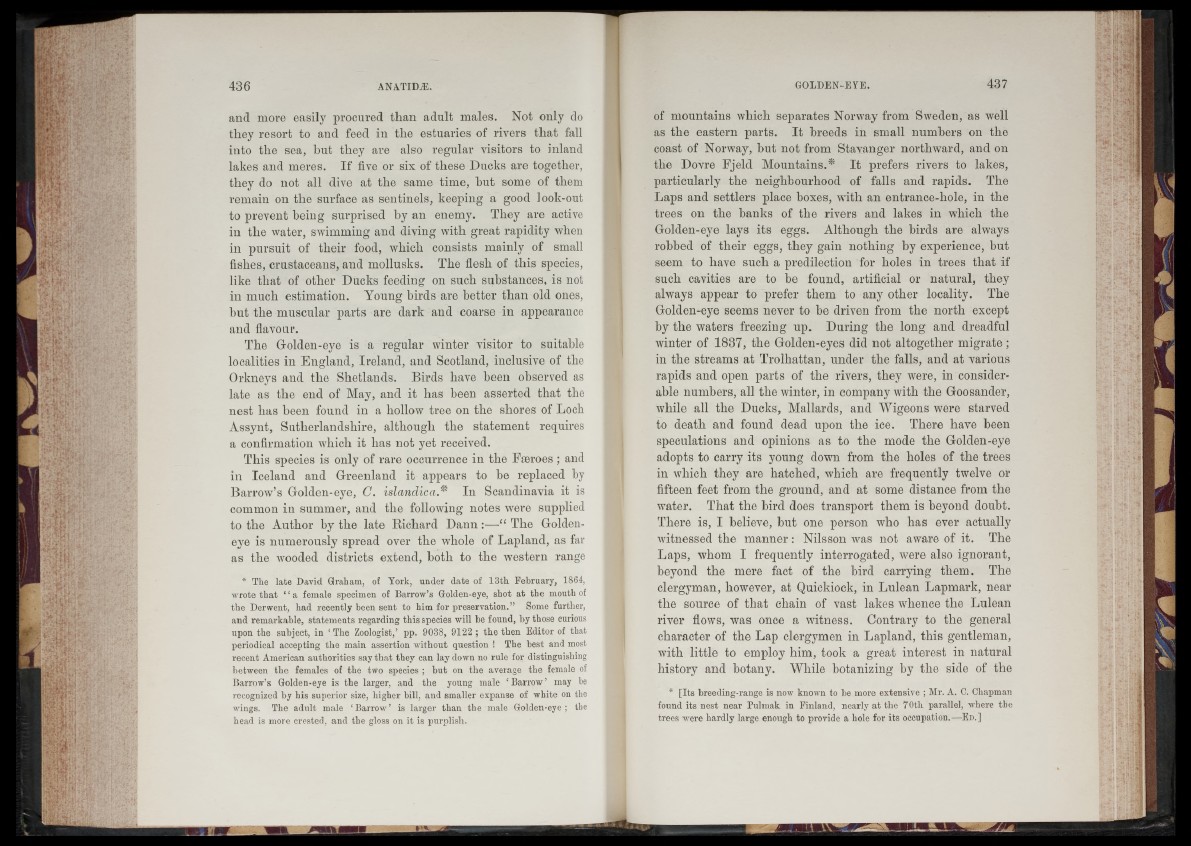
and more easily procured than adult males. Not only do
they resort to and feed in the estuaries of rivers that fall
into the sea, but they are also regular visitors to inland
lakes and meres. If five or six of these Ducks are together,
they do not all dive at the same time, hut some of them
remain on the surface as sentinels, keeping a good look-out
to prevent being surprised by an enemy. They are active
in the water, swimming and diving with great rapidity when
in pursuit of their food, which consists mainly of small
fishes, crustaceans, and mollusks. The flesh of this species,
like that of other Ducks feeding on such substances, is not
in much estimation. Young birds are better than old ones,
but the muscular parts are dark and coarse in appearance
and flavour.
The Golden-eye is a regular winter visitor to suitable
localities in England, Ireland, and Scotland, inclusive of the
Orkneys and the Shetlands. Birds have been observed as
late as the end of May, and it has been asserted that the
nest has been found in a hollow tree on the shores of Loch
Assynt, Sutlierlandshire, although the statement requires
a confirmation which it has not yet received.
This species is only of rare occurrence in the Faeroes; and
in Iceland and Greenland it appears to be replaced by
Barrow’s Golden-eye, C. islandica.* In Scandinavia it is
common in summer, and the following notes were supplied
to the Author by the late Bichard Dann:—“ The Goldeneye
is numerously spread over the whole of Lapland, as far
as the wooded districts extend, both to the western range
* The late David Graham, of York, under date of 13th February, 1864,
wrote that “ a female specimen of Barrow’s Golden-eye, shot at the mouth of
the Derwent, had recently been sent to him for preservation.” Some further,
and remarkable, statements regarding this species will be found, by those curious
upon the subject, in ‘The Zoologist,’ pp. 9038, 9122; the then Editor of that
periodical accepting the main assertion without question ! The best and most
recent American authorities say that they can lay down no rule for distinguishing
between the females of the two species ; but on the average the female of
Barrow’s Golden-eye is the larger, and the young male ‘Barrow’ may he
recognized by his superior size, higher bill, and smaller expanse of white on the
wings. The adult male ‘Barrow’ is larger than the male Golden-eye; the
head is more crested, and the gloss on it is purplish.
of mountains which separates Norway from Sweden, as well
as the eastern parts. It breeds in small numbers on the
coast of Norway, but not from Stavanger northward, and on
the Dovre Fjeld Mountains.* It prefers rivers to lakes,
particularly the neighbourhood of falls and rapids. The
Laps and settlers place boxes, with an entrance-hole, in the
trees on the banks of the rivers and lakes in which the
Golden-eye lays its eggs. Although the birds are always
robbed of their eggs, they gain nothing by experience, but
seem to have such a predilection for holes in trees that if
such cavities are to be found, artificial or natural, they
always appear to prefer them to any other locality. The
Golden-eye seems never to be driven from the north except
by the waters freezing up. During the long and dreadful
winter of 1837, the Golden-eyes did not altogether migrate ;
in the streams at Trolhattan, under the falls, and at various
rapids and open parts of the rivers, they were, in considerable
numbers, all the winter, in company with the Goosander,
while all the Ducks, Mallards, and Wigeons were starved
to death and found dead upon the ice. There have been
speculations and opinions as to the mode the Golden-eye
adopts to carry its young down from the holes of the trees
in which they are hatched, which are frequently twelve or
fifteen feet from the ground, and at some distance from the
water. That the bird does transport them is beyond doubt.
There is, I believe, but one person who has ever actually
witnessed the manner: Nilsson was not aware of it. The
Laps, whom I frequently interrogated, were also ignorant,
beyond the mere fact of the bird carrying them. The
clergyman, however, at Quiekiock, in Lulean Lapmark, near
the source of that chain of vast lakes -whence the Lulean
river flows, was once a witness. Contrary to the general
character of the Lap clergymen in Lapland, this gentleman,
with little to employ him, took a great interest in natural
history and botany. While botanizing by the side of the
* [Its breeding-range is now known to be more extensive ; Mr. A. C. Chapman
found its nest near Pulmak in Finland, nearly at the 70th parallel, where the
trees were hardly large enough to provide a hole for its occupation.—En,]